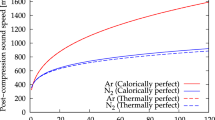Abstract
Tuned free-piston driver operation involves configuring the driver to produce a relatively steady blast of driver gas over the critical time scales of the experiment. For the purposes of flow condition development and parametric studies, it is useful to establish some average working values of the driver pressure and temperature for a given driver operating condition. However, in practise, these averaged values need to produce sufficiently accurate estimates of performance. In this study, two tuned driver conditions in the X2 expansion tube have been used to generate shock waves through a helium test gas. The measured shock speeds have then been used to calculate the effective driver gas pressure and temperature after diaphragm rupture. Since the driver gas is typically helium, or a mixture of helium and argon, and the test gas is also helium, ideal gas assumptions can be made without significant loss of accuracy. The technique is applicable to tuned free-piston drivers with a simple area change, as well as those using orifice plates. It is shown that this technique can be quickly used to establish average working driver gas properties which produce very good estimates of actual driven shock speed, across a wide range of operating conditions. The use of orifice plates to control piston dynamics at high driver gas sound speeds is also discussed in the paper, and a simple technique for calculating the restriction required to modify an established safe condition for use with lighter gases, such as pure helium, is presented.



Similar content being viewed by others
References
Jacobs, P.A.: Quasi-One-Dimensional Modelling of a Free-Piston Shock Tunnel. AIAA J. 32(1), 137–145 (1994)
Gollan, R.J., Jacobs, P.A.: About the formulation, verification and validation of the hypersonic flow solver Eilmer. Int. J. Numer. Methods Fluids 73(1), 19–57 (2013)
James, C.M., Gildfind, D.E., Morgan, R.G., Jacobs, P.A., Zander, F.: Designing and Simulating High Enthalpy Expansion Tube Conditions. In: Proceedings of The 2013 Asia-Pacific International Symposium on Aerospace Technology, Takamatsu, Japan, Nov 20–22 (2013)
Stalker, R.J.: Isentropic Compression of Shock Tube Driver Gas. ARS J. 30, 564 (1960)
Itoh, K., Ueda, S., Komuro, T., Sato, K., Takahashi, M., Myajima, H., Tanno, H., Muramoto, H.: Improvement of a free piston driver for a high-enthalpy shock tunnel. Shock Waves 8, 215–233 (1998)
Stalker, R.J.: A study of the Free-Piston Shock Tunnel. AIAA J. 5(12), 2160–2165 (1967)
Hornung, H.G., Belanger, J.: Role and Techniques of Ground Testing for Simulation of Flows Up to Orbital speed. In: Proceedings of the AIAA 16th Aerodynamic Ground Testing Conference, Seattle, WA, Jul 18–20, AIAA-90-1377 (1990)
Gildfind, D.E., Morgan, R.G., McGilvray, M., Jacobs, P.A., Stalker, R.J., Eichmann, T.N.: Free-piston driver optimisation for simulation of high Mach number scramjet flow conditions. Shock Waves 21(6), 559–572 (2011)
Hornung, H.G.: The piston motion in a free-piston driver for shock tubes and tunnels. GALCIT Report FM 88–1, Graduate Aeronautical Laboratories, CALTECH, California (1988)
Gildfind, D.E., Morgan, R.G., McGilvray, M., Jacobs, P.A.: Production of High-Mach-Number Scramjet Flow Conditions in an Expansion Tube. AIAA J. 52(1), 162–177 (2014)
Gildfind, D.E.: Development of High Total Pressure Scramjet Flow Conditions Using the X2 Expansion Tube, Ph.D. thesis, Division of Mechanical Engineering, School of Engineering, The University of Queensland, Brisbane, Australia (2012)
Morgan, R.G.: Chapter 4.2: Free-Piston Reflected Shock Tunnels. In: Ben-Dor, G., Igra, O., Elperin, T. (eds.) Handbook of Shock Waves, Vol. 1, pp. 587–601. Elsevier, San Diego (2001)
Anderson, J.D.: Modern Compressible Flow with Historial Perspective, 3rd edn. McGraw Hill, Singapore (2003)
Gordon, S., McBride, B.J.: Computer Program for Calculation of Complex Chemical Equilibrium Compositions and Applications. Technical Report Reference Publication 1311. NASA, Cleveland, Ohio (1994)
Acknowledgments
The authors wish to thank: Mr. F. De Beurs for technical support; The Australian Research Council for support and funding; The Queensland Smart State Research Facilities Fund 2005 for support and funding.
Author information
Authors and Affiliations
Corresponding author
Additional information
Communicated by H. Olivier.
Rights and permissions
About this article
Cite this article
Gildfind, D.E., James, C.M. & Morgan, R.G. Free-piston driver performance characterisation using experimental shock speeds through helium. Shock Waves 25, 169–176 (2015). https://doi.org/10.1007/s00193-015-0553-8
Received:
Revised:
Accepted:
Published:
Issue Date:
DOI: https://doi.org/10.1007/s00193-015-0553-8




